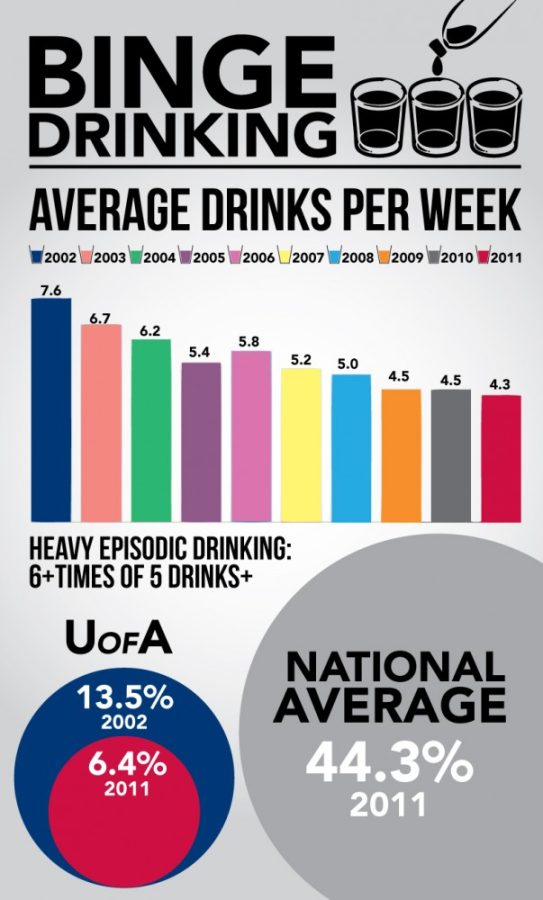UA students are drinking less, but are still facing alcohol-related academic consequences, according to the latest UA Health and Wellness survey conducted by the Campus Health Service.
The average student consumed 7.6 drinks in a week in 2002, according to the 2002 survey. In the 2011 survey, data showed the average UA student has 4.3 drinks a week, a 43 percent decrease.
“It’s pretty much like a staircase effect,” said David Salafsky, director of Health Promotion and Preventive Services. “These are not numbers we have been seeing bounce up and down over the last few years, so it is significant.”
Though the level of alcohol consumption has decreased on the UA campus, the number of students who miss class due to drinking has continue to be high and in flux over the last six years. The survey indicates 18.8 percent of UA students have skipped classes because of alcohol consumption within a 30-day period of taking the survey. One of the things Salafsky found in his studies is that students are engaging in more credit units than in previous years, providing them less of an opportunity to recover from a night or day of drinking.
“As a result, when students do drink, it’s more likely going to impact academics that next day just because there is less spacing in the schedule,” Salafsky said. While the UA campus has seen a decrease in alcohol consumption over the last few years, national trends paint a different picture. According to a study conducted by Center for Science in the Public Interest, 44.3 percent of college students in the United States partake in frequent and heavy episodic drinking, otherwise known as binge drinking. This is a term Campus Health refrains from using when describing students who excessively drink.
“‘Binge’ just conjures up the idea of mass quantities or negative images, and the truth is a lot of students do engage in heavy episodic drinking, so this is what we tend to call it,” said Lee Ann Hamilton, assistant director of Health Promotion and Preventative Services for Campus Health. “And as the data suggest, we also know a lot of students who don’t do that, but we’re concerned about those who might be heavy drinkers with what the risks and consequences might be.”
The Center for Science in the Public Interest defines a heavy episodic drinker to be a person who consumes more than five drinks on at least one occasion during a 30-day time span.
“It makes sense just because it is a strong amount of drinking within one period and gaps in between,” said Lance Leon, a history junior. “Maybe a month is a little too much to be called excessive drinking, but I can see where they are coming from.”
In the Campus Health survey, statistics showed a decrease in heavy episodic drinking at the UA, dropping from 7.9 percent in 2010 to 6.3 percent in 2011. Hamilton, who is also an instructor for Student Health Alcohol Drug Education, a diversion class for UA students facing minor in possession citations, said she is often surprised to see how many students are unaware of their blood alcohol concentration.
Their blood alcohol concentration and how many drinks it takes to push someone over the legal limit and into the territory of driving under the influence is .08 percent on a Breathalyzer test.
“That one red cup, depending on what is in it, could be several drinks,” Hamilton said. “Students are not really aware of a standard drink and not aware of the differences weight and gender may make.”









